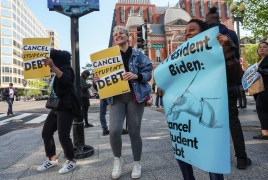
In recent decades, the cost of college has risen faster than overall inflation and family incomes, and states have reduced funding for public education. As a result, student loan debt has soared and now tops $1.6 trillion. Many students fear that they will not be able to repay their loans and that monthly payments will make homeownership and child-rearing unaffordable.
Not surprisingly, student loan relief has become an important political issue. Starting in 2016 with Senator Bernie Sanders’ campaign for the Democratic presidential nomination, candidates and grassroots activists have pushed for loan forgiveness and other measures to ease the financial burden of college attendance.
During his 2020 campaign, Joe Biden refused to endorse the total cancellation of student loan debt urged by many advocates but promised to forgive at least $10,000 for each borrower. Last week, he signed an executive order to forgive $10,000 for borrowers who attended colleges and universities and make less than $125,000 per year—and $20,000 for recipients of Pell grants. In addition, he took steps to ease repayment terms for current and future loan recipients enrolled in a program that sets monthly payments as a share of their earnings after they leave college.
The president’s announcement generated both excitement and criticism. Some Democrats—including Senate candidates running in swing states—kept their distance from the plan, fearing that it could strengthen the perception that their party did not care about non-college blue-collar Americans. Many Republicans charged that the president had exceeded his legal authority and threatened lawsuits to overturn his plan.
Findings from recent survey research
Public opinion surveys—some conducted after the president’s announcement, others in the months that preceded it—illuminate the strengths and vulnerabilities of President Biden’s plan in the eyes of the electorate. Here are some of the principal findings.
Although most Americans have never had a student loan and fewer than one in five now have one, the issue directly touches a wide swath of the public. Among registered voters, 15 percent will have their loans reduced or completely forgiven, 25 percent have family members eligible to participate in the plan, and 18 percent have close friends in this situation.
A majority of voters believe that there were compelling reasons for the president to act. Two thirds say that student loan debt is a serious problem, and more than six in 10 say that it is preventing young people from buying homes and having children. Sixty-three percent see student loan debt relief as lightening financial burdens, especially on low-income households.
Every survey has shown majority but not overwhelming support for President Biden’s plan to reduce the burden of student loan debt. The two most recent polls, Quinnipiac and The Economist/YouGov, put support among registered voters at 51 percent and 52 percent, respectively. Support among Hispanic and Black voters was substantially stronger, as was support among voters under age 50. Among swing voters, moderate and suburban voters gave the plan majority support while Independents were about evenly divided. Women are significantly more favorable to the plan than men, and the gender gap is especially large among white Americans.
Every element of the plan enjoys majority support. In a detailed battery of questions, the Economist/YouGov poll found majorities of voters in favor of extending the payment moratorium until the end of the year, cancelling $10,000 of debt for individuals earning less than $125,000, capping monthly payments at five percent of a borrower’s monthly income, forgiving loan balances of $12,000 or less after 10 years of payments, and having the federal government cover unpaid interest for borrowers making monthly payments based on their income.
Table 1. Voter support for President Biden’s loan forgiveness plan
| Elements of President Biden’s plan | Favor (%) |
Oppose (%) |
| Cancel $10,000 of student debt | 52 | 41 |
| Cap monthly payments | 57 | 21 |
| Forgive loan balances after 10 years | 50 | 36 |
| Cover unpaid interest | 57 | 28 |
Source: Economist/YouGov
The president’s plan seems to have found a “sweet spot” in public opinion. Voters are divided almost equally among those who think $10,000 in loan forgiveness is too much, too little, and about right, and public support declines when the amount is increased above this level.
Despite broad support for student loan relief, Americans have a range of qualms about President Biden’s plan. They are evenly divided on the threshold question of whether the president has the legal authority to cancel student loan debt, an issue that is certain to be contested in court. More than half of the electorate believes that debt cancellation will cause inflation to increase. More than half believes that it is unfair to Americans who did not attend college—and to Americans who have already paid off their student loans. Many worry that the plan does nothing to reduce the cost of attending college and could actually worsen the price spiral.
The politics of student loan relief
These doubts could expose the president’s plan to potent political attacks during the midterm election campaign. Still, its beneficiaries are likely to care more about the issue than do its critics, and it is relatively popular among key groups of swing voters, such as Independents, moderates, suburbanites, and Hispanics. And although many economists believe that the student loan program itself is in part responsible for the soaring cost of higher education, voters are much more likely to blame colleges and universities, along with banks and other lending institutions, for this unwelcome trend. If critics attack the plan too aggressively, they could be portrayed as heartless and out of touch with the needs of more than 40 million Americans. If it motivates previously disengaged younger voters to participate in the midterm elections, it will boost Democrats’ prospects, especially in contested races where turnout will be key.


